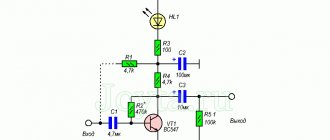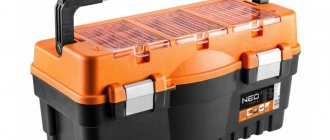What kind of bags can there be?
Bags are not only lighter and more practical than boxes, but they also cost less. The tool bag can have different appearances. One of the formats is rectangular and equipped with handles and a shoulder strap.
There is another option for a tool bag. It has a belt clip and, of course, has a smaller capacity. This tool belt bag is indispensable for minor repairs at home, and is also popular with electricians, gardeners and hairdressers. Also, all container options have different shapes. They can be completely fabric or have plastic inserts. You can easily make a tool bag with your own hands. But first, it’s still worth understanding the various options.
Types of mounting bags
Mounting bags for tools can be of three types:
Shoulder. Such models are quite popular because they have a low cost. However, they soon lose their impeccable appearance. Such products are characterized by soft, easily deformable walls, which is why they are not always comfortable to use.
Belted. The tool mounting belt looks like a small tablet, equipped with pockets, loops and hooks.
In the form of a vest. This is the most ergonomic type of construction organizer. Most often they are made from a denim vest, equipped with a spacious storage system.
Professional models are sewn from nylon fabric. They are equipped with a huge number of fasteners and pockets. Such a large number of compartments can also be a disadvantage - when fully filled, they make the vest very heavy.
One of the most popular models of mounting bags is the Dewalt tool belt. This company has an excellent reputation for creating reliable instrument storage systems.
Classic bag for storage and transportation
The distribution of space inside the bag plays an important role when choosing a model. Usually the bag is closed at the top with a lock, which can have a different appearance. It could be a zipper, a buckle, a cord, or even a padlock.
Inside the bag is divided into several sections, different in size. Most often, such departments also have an individual clasp. Each pocket or part of them can be fastened. In addition, there are several pockets on the outside. Or there is another option when the bag consists of several departments that look like folders. These folders are fastened together with a zipper and can also have individual fasteners. This type of bag is suitable for storing a large number of small tools. While the first option is used for larger ones. In addition to sections and pockets, there may also be additional fasteners or elastic bands under which tools can also be placed. Many manufacturers even draw silhouettes of the tools that should be there under such fasteners.
Barber bag
Hairdressers belong to that group of workers who often have to go to clients' homes. Of course, they will need a container to transport the tool. But that is not all. Since hairdressers are forced to move around the client during their work, belt bags will also be very convenient for them.
Bags for hairdressing tools used for transportation should have good, roomy compartments and preferably with thick partitions. A bag that fits on a belt may not have many pockets. Just a few are enough - for scissors, combs and clips.
Mounting belt
Any master of small household repairs knows first-hand what a mounting belt is. A tool bag of this type looks like an apron, equipped with two large and several medium pockets.
In addition, these pockets have slots for small tools, as well as loops for a hammer. Such belts are very convenient because they allow you to keep a large number of different tools with you. This container is often used as an electrician's tool bag. This is due to the ease of use of this option when working at heights. After all, with such an “assistant” you don’t have to constantly get off the stepladder to pick up a new tool.
How to make a tool belt with your own hands?
Beginners are advised to choose a model that is as easy to make as possible. Before starting work, you need to find out the appropriate volume of the future product and determine the location of all pockets. For clarity, it is advisable to draw a sketch.
To make such a product, you can use various materials (for example, canvas, unnecessary jeans, straps ). To make such a belt from old jeans, you will need the appropriate material, a sewing machine and scissors.
Stages of work:
- You need to cut off the belt from jeans . Using the existing clasp, it will later be attached to the waist.
- Now you should cut out the pockets located at the back and sew them to the belt . If the pockets have rivets, this will be an added advantage when storing supplies and small tools.
- Next, you need to cut a small piece of fabric from one of the legs and fold it in half, forming a pocket. Then, leaving 2 cm at the top for attaching this pocket to the belt, sew the sides of the pocket and add 2 additional vertical stitches, thus dividing it into 2 more pockets, which can later be used for small tools.
Advice! This model can, if desired, be supplemented with various pockets to suit your taste. But it is not recommended to make more than 10 pockets.
Construction belt
A product of this type must be spacious enough to accommodate all the tools required for the job. Since a product of this kind is subjected to significant stress during use, it is necessary to use only durable, good quality elements to sew it.
A construction belt without straps (with a button) is convenient because it does not unfasten during work. The model with straps is fixed on the chest and on the back, without impeding movement during use. This allows you to use more tools in your work.
Mounting
Quite high demands are placed on such products. Such a thing must be thought out in detail to prevent a fall from a height in the event of a force majeure situation .
The mounting belt must have reliable fastenings that can be placed in different places depending on the specifics of the work.
In addition, products of this type have small compartments designed for small tools and loops for a hammer.
With such attributes you can keep a fairly large number of tools with you, which is very convenient. Products of this type are often used by electricians in their work.
Advice! It is recommended to place the hammer and chisel in such belts on opposite sides.
Types of mounting belt bags
Belts for installers are divided into:
- shoulder ones (very popular due to their low cost, but have soft, quickly deformed walls, and quickly lose their original appearance);
- waist (look like a small tablet, equipped with pockets, hooks and loops);
- in the form of a vest (the most ergonomic type of such organizer, in most cases made from a denim vest).
Reference! Professional models are made from genuine leather or rigid nylon fabric, which do not absorb moisture and oil. Such products have an impressive number of pockets and fastenings, but when filled to the maximum they can make the vest excessively heavy.
Bag for manicurist
Manicurists do not need to use fanny packs, since they work at a table and all the tools are laid out in front of them. And it doesn’t matter where it happens: in the salon or at the client’s. But when going to a client’s home, they are forced to transport a large amount of materials and tools. In addition, the walls of the bag should be as tight as possible so that the materials being carried cannot turn over too much to prevent them from spilling or mixing.
Therefore, bags for manicure tools are large in size, in the form of suitcases with several compartments that keep their shape perfectly, as well as many pockets. In such bags everything is always in its place. Such suitcases are fastened with a lock and have two types of handles: long and short. In addition to the usual sections, a manicure case usually has a plastic frame that is sliding. The tools that the master is currently using can be placed on it. After work, the sections of the bag simply slide together and the suitcase closes, which is very convenient.
Sewing Master Class: Tool Bag
Author: Lyudmila Kleus (Lvovna.)
Author's blog
Today I want to show you how to sew a tool bag. I drive my car a lot, but I never pay attention to the various knocking and rattling noises that are sometimes heard in the cabin. My husband, on the contrary, all the time just listens to where something happened... So we are going, for example, to the dacha, I tell him something, I become like a nightingale, I describe everything so colorfully, in faces, with foam on my lips, and he suddenly, in the middle of my monologue, suddenly declares: “Something hit. Listen, where is this? In the first moments, I can’t even figure out what’s going on. It is very difficult to switch from your thoughts to his. Then I start turning my head in all directions, catching sounds. Sometimes I even crawl my head under the seat. So I turn in all directions until we reach our destination... And then what kind of monologue did I have on the way - I forgot what I was talking about... So that’s what I’m talking about... All men carry tools with them in the car, which may come in handy on the road. They, as a rule, are in original boxes, convenient packaging, etc.... In short, in sets. But there are all sorts of screwdriver keys, not in sets, but in bulk, which you can’t throw away and you have to carry them in different boxes or old buckets and boxes. Well, maybe I’m exaggerating a bit, but still. And these instruments begin to strum on every bump, preventing us women from chatting about this and that, because they distract the attention of our counterpart. So, my dears, today I will show you how to sew a bag for tools in which they will not rattle. I have already sewn 5-6 such bags, I don’t remember exactly, but they were all made of thin tarpaulin. Now I haven’t found a thin tarpaulin, so I’m showing you one on dermantine. This is the kind of bandoleer for tools we will sew today. So let's get started.
For this we need:
- dermantine or other dense fabric (you can also use an old tapestry);
- trouser braid;
- Velcro tape;
- tailor's pins (my pins are at the dacha, so I used decorative ones);
- chalk;
- pencil;
- rulers;
- threads, scissors.
Girls, I can’t give you a pattern for such a thing, because everything here is strictly individual. Whatever tools a man gives you, that’s how you should size them. So, take a piece of dermantine and bend the bottom to the size of the largest tool. In this case, I have the key. We lay out all the tools we need, deciding on the length of the bag and the number of cells in the pocket.
Use a tailor's pin to pin the cell to the required width.
We do the same with all other tools. Oh, where have our tools gone? Hush, girls, don't panic! The situation is under control!
Here they are, my dears! They simply fell headlong into these deep cells.
We take out all the tools and begin cutting and adjusting the bag to size. We draw a line with chalk along which we will cut off the excess. Don't forget the hem allowance!
Trimmed. 3-3.5 centimeters above the largest key, draw a line parallel to the top cut of the pocket.
This is what we got. Stepping back 2 cm from the top of the pocket, draw a line along which we will make a fold.
They turned it down. Stitched. I laid 2 parallel lines.
Now we remove the pins and draw seam lines using the marks with chalk.
Let's sew. To strengthen the seams, I stitched back and forth along one line. For ease of work and to prevent pins from pricking, I rolled the product into a roll.
So, we stitched. This is what we got. The pocket with cells is ready. Now we need to sew a valve that will cover our tools on top. We place the resulting part on a piece of newspaper, determine the height of the valve and cut off the excess around the perimeter.
We try on the part obtained from the newspaper to our pocket. This is what the bag flap will look like. We cut out the valve from dermantine.
We begin to process the bottom of the valve with braid. From the wrong side to the bottom of the flap, we overlap the braid and stitch it. The overlap width is 5-6 mm.
We turn it over to the front side, fold the braid over it and stitch it. Having processed the bottom of the valve, we begin to process its sides. On the sides we sew a braid 6-7 mm longer than the bottom edge.
Girls, we leave these tips only on the sides of the parts and only at the bottom! Look at photo 19. The top and bottom of the product are clearly visible there.
We tape the sides of the bottom of the bag.
This is what the ends should look like. This is necessary in order to carefully process the bottom of the resulting seam. We will fold this tip onto the back of our bag and attach it with a zig-zag stitch in one place. For those who don’t have such a stitch, you can simply attach it with a needle and thread.
This is how you get the corner of the valve.
So, we have two parts - the valve and the pocket itself. We place the flap on the pocket, align the top edge and trim it with braid.
This is what we ended up with. The bag is ready. Almost…
We begin to arrange the tools into cells. Small keys are clearly drowning in their cells! Here's what we do...
We place all the small keys on the cells on the same level as the large ones. Under the small keys we draw a line with chalk, along which we will sew a double line - these are the future bottoms of the cells. We draw a line under the smallest keys on each cell, not reaching the side seams. Look, see? We will make cuts along these lines with a stationery knife. Insert a ruler into these two cells one by one and cut along these lines with a knife or scissors. Just be careful not to cut through the seams! And watch your fingers!
That's it. Stitched, cut through. They put the tools in their places. This is what we got. What? Are you asking why the last cell is empty? And this is a surprise for our man! I'll show you a little lower.
So, we sewed the bag. We roll it up into a roll and measure the required length of the Velcro tape, which is hooked at the very tip. Don't cut it short! It's better to have a reserve.
We sew the interlocked ends like this - double stitching around the perimeter.
We apply it to the bag at the attachment point.
Girls, we sew the ribbon not along the square, but along the yellow stripe that I drew! Make no mistake! So, the braid was sewn on with a triple stitch (back and forth).
And now our bag is completely ready! Oh, you're asking what's in the last pocket? Here's what...
Stash! Every man should have a stash, so we made it! Let him spend certain sums there, let him! We'll have everything under control, right? Just shhh, don’t tell anyone about this! And the man himself will be so glad that he has a place for his stash!
Well, this is what we sewed for you today! Not bad, right? By the way, my husband spent the whole evening moving different instruments back and forth, hence the different variations of the sets. Another good thing about this bag is that you can immediately see if any tool is missing after repair. You can’t roll it up half empty, right? And sometimes men forget different screwdrivers and keys where they were repairing. Then they shake us poor people like a pear - where did you put the key to twelve???
And here is the handbag assembled. There won’t be anything rattling in the trunk now, so chat to your heart’s content—no rattling in the trunk will stop your man from listening to you attentively!
Selection of material
A DIY tool bag can be made from various materials. And they play not the least role. Of course, the materials used to sew bags are not particularly diverse. As a rule, preference is given to one of two options. It can be nylon or leather. The first one is the most accessible and also universal. It is much cheaper than leather, which is why it is used much more often. But still, leather bags are much stronger and more resistant to use. Leather bags are also heavier than nylon bags and require special care, and this can be attributed to their disadvantages. Nylon is lightweight and washable, yet quite durable. Another advantage of it is the variety of color shades, unlike leather, which is presented in only a few solutions. But the disadvantages include its fragility. Such material can be easily damaged by tools from the inside. But if you are planning to sew for the first time, then you can practice, for example, on ordinary oilcloth, which has a fabric base. After all, sewing a leather bag will require some experience and equipment.
Tool bag pattern
Patterns for bags of this kind are usually not too complex. As a rule, these are several squares and rectangles connected into one whole.
But the sequence of their connection will depend on the chosen model, as well as on the purpose for which this bag will be used. Before you calculate everything and build a pattern, you need to decide not only on the model, but also on its size and number of sections. It would be a good idea to foresee in advance exactly which tools will be located in which departments.
Also consider the location and type of fastener, as well as handles and the placement of the pockets themselves. They can be located on one side or around the entire bag. Consider this moment especially carefully in a belt bag.
Sewing process
Having decided on the model and selected the material, you can start sewing. The constructed pattern should be placed on the wrong side of the fabric, pinned and cut out. If you use oilcloth, then seam allowances are not needed. The easiest way is to sew a bag in the form of an apron. One main piece is cut out, onto which square or semicircular pockets of different sizes are sewn. All cut parts should be finished along the edges, for example with hemming tape. A fabric belt should be sewn to the main part at the top. Oilcloth will not work for this because it cannot be tied around the waist.
Now that the main part of the bag is ready, you should place the pockets on it where you want them to be in the finished version and pin them in place. Inspect the work, and if everything suits you, then sew the pockets finally. This model can be slightly modified. Make a wide belt from oilcloth that will not be tied, but fastened. Each pocket is sewn separately and in this case consists of two halves. After all the pockets are ready, they are sewn on top of the belt along its entire length. They can also be stacked on top of each other. This way you will increase the useful volume of the belt bag.
When starting to choose a bag model for your tools, the first thing you should correctly calculate is its volume. It will depend on how many tools you would like to store or carry there. It should be remembered that you cannot fill the bag to capacity. This will harm not only the product, but also the tools themselves. As they move, they will rub against each other, which will undoubtedly lead to faster wear. The next thing you need to pay attention to is the presence of pockets, compartments and their functionality. It’s very good if some of them are fastened, and some remain open, then the most necessary tools will always be at hand. The choice of color also matters. After all, when a bag is used for repair work, it is preferable if the dirt on it is not too noticeable.
Tips for use
When using such items, it is recommended to take into account several important nuances:
- You cannot fill such a product with tools to capacity. This will damage not only the belt itself, but also the instruments themselves.
- The number of pockets and their functionality play an important role. The best option is to fasten some of the pockets, while others remain open. In this case, everything you need can be kept at hand at all times.
- It is better to choose (or make) a product of the appropriate color, on which dirt will not be particularly noticeable. This is especially important for those items that are planned to be used in repair work.
- This item can be cleaned with ordinary soap and water. It is better not to dry it on the radiator. This can reduce the wear life of the product.
Important! The hammer compartment should be located on the side of the working hand.
To make your own tool belt, you don’t need any special knowledge or skills. Such a product, which provides convenient carrying and transportation of the required number of tools, small parts and consumables, will come in handy more than once at home, in the country and in the garage.
Thursday salt - healing and magical properties
How to clean a comb with natural bristles?











